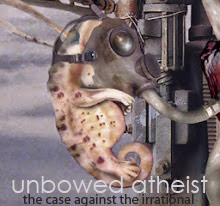|
|
UNBOWED ATHEIST
reason the enemy of belief
Unbowed
Atheist first appeared as a Demetrios Vakras
blog when 10 articles were published on 15 June
2013. These articles can still be found at http://vakras.blogspot.com.au
SLEEP OF REASON
BREEDS THEISM |
www.unbowedatheist.com/degenertate_art_surrealism.html
6/1/2015
EMILIOS KYROU - SURREALISM UNLAWFUL
second essay [gelded - re-edited, later] 7/1/2015
The Nazis objected to surrealism, claiming it advanced Jewish interests
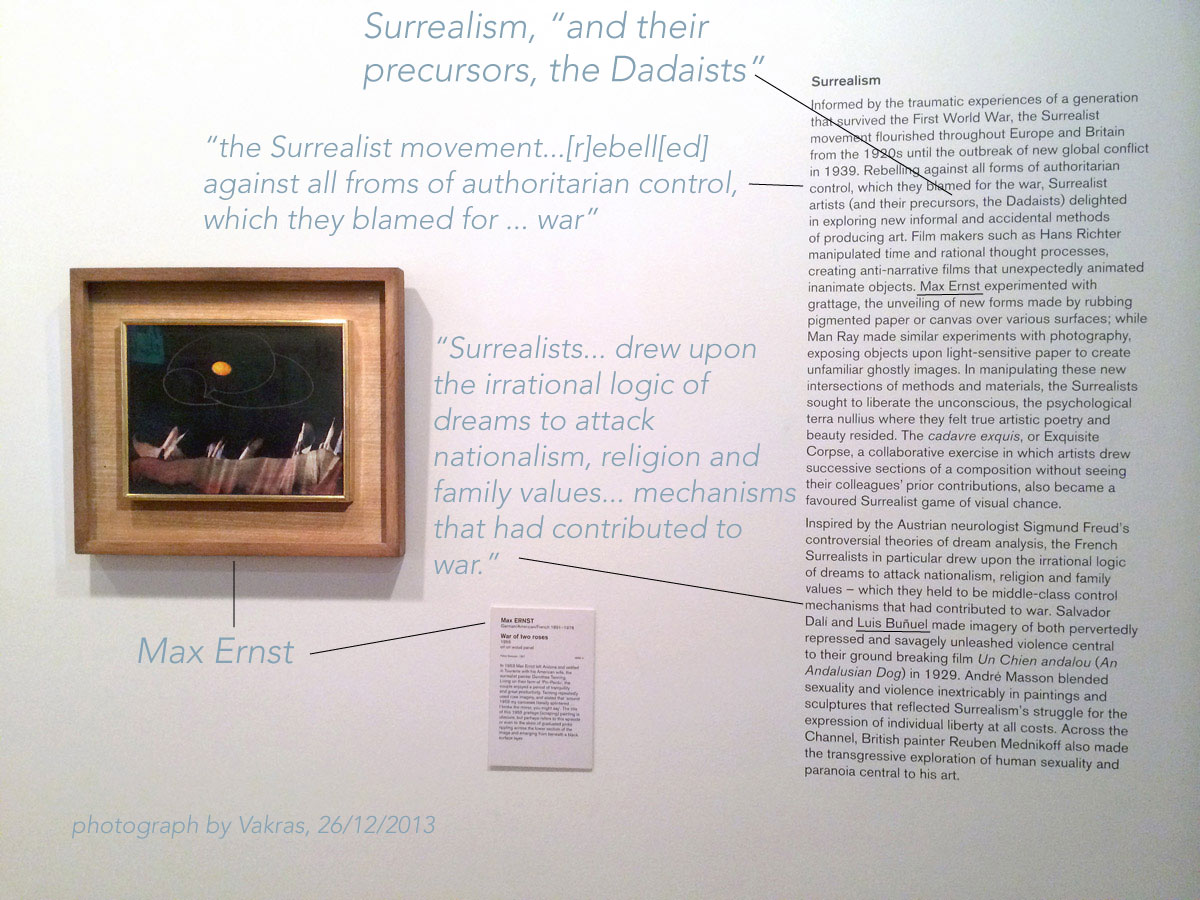
(1) Surrealism
defined by the state art museum (NGV) 26/12/2013 (above):
surrealism is anti-religion; surrealists considered religion
to be a mechanism that contributes to war.
In the 2009 surrealist exhibition, Humanist
Transhumanist, religion was condemned for its assault
on secular values (2). Judaism, Christianity, Islam and
Zoroastrianism were criticised.
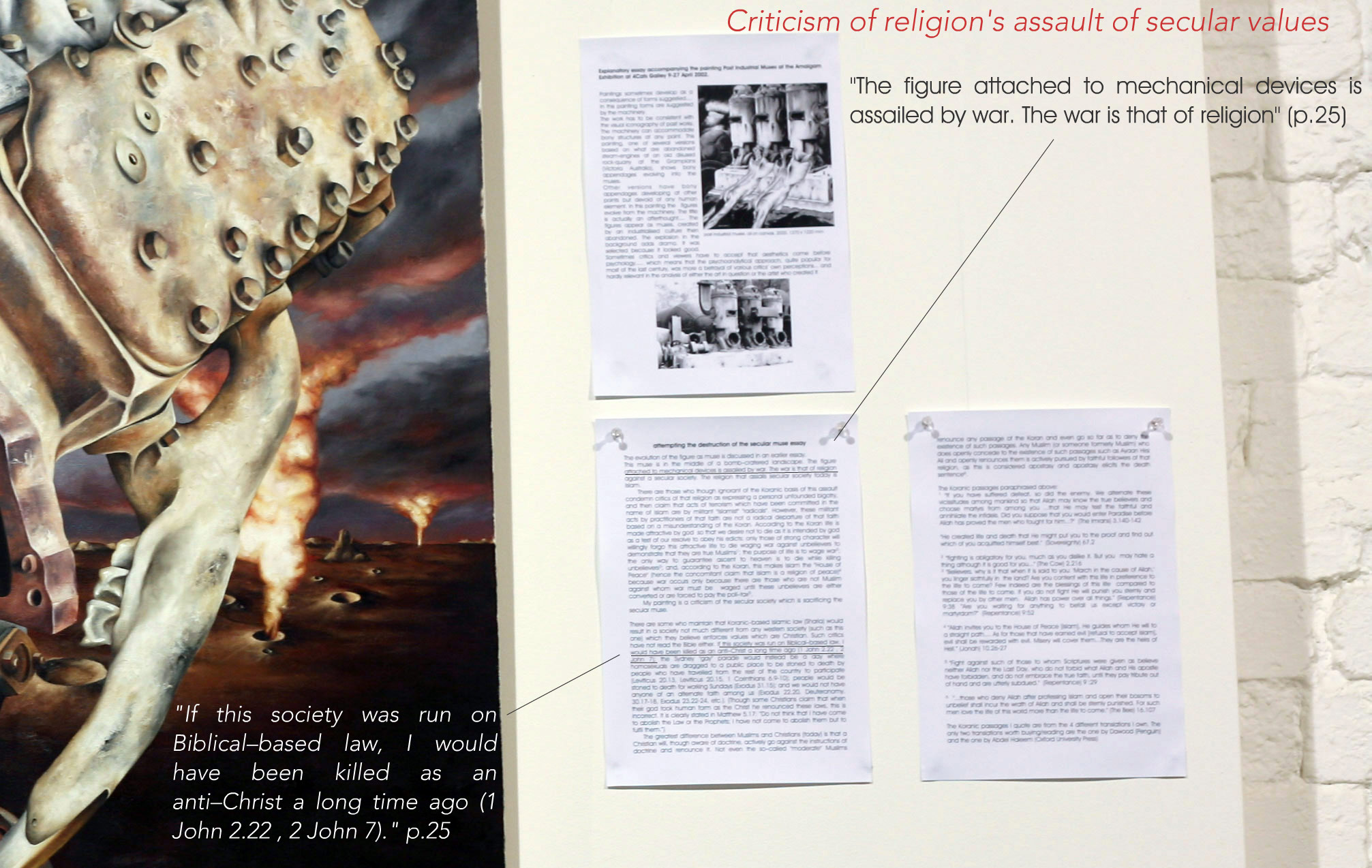
(2)
The owner of the gallery,
Robert Cripps (who now runs an entertainment venue, Ruby's
Music Room), proclaimed that criticism of Islam (out of all
the religions criticised) constitutes "racism".
I wrote about Cripps' bizarre proclamations and the actions
he took in 2009 and in 2011 he sued for defamation,
claiming what was written was an "injurious falsehood". The
case was heard by Emilios Kyrou.
This page is an analysis of
Kyrou's ruling in the context of what surrealism is.
Kyrou ruled about surrealist
works, which, being surrealist, are atheist.
The views and attitudes held on surrealism by the Nazis:
The Nazis saw in the anti-religious nature of surrealism an
attribute that was Jewish; saw in surrealism a
manifestation of something Jewish; something that aided a
Jewish idea, a Jewish objective or Jewish understanding, or
expressed a sentiment that was Jewish; and in doing this
"Jewish act", with that act being a surrealist's rejection of
religion, surrealism harmed non-Jews and that this benefited
Jews.
Regarding the criticism I made of religion in 2009, Emilios
Kyrou, Αιμίλιος Κύρου, ruled in 2014, that criticism (of
Islam) harmed non-Jews, "Palestinians", who both he and Cripps
agreed were Muslims (to the exclusion of other Palestinians
who are not Muslim, such as the Jews of Palestine).
That is, Αιμίλιος Κύρου found
that the criticism of Islam could be seen to be beneficial to
Jews at the expense of non-Jews (Muslims).
Kyrou ruled that atheist criticism of religion (Islam), made
in a surrealist exhibition, (which criticised Christianity,
Judaism and Zoroastrianism as well) would assist a Jewish
interest, with that Jewish interest being the "Jew's state in
Palestine" which was not mentioned or alluded to. And that this harmed the non-Jews of "Palestine”,
Muslims. Kyrou's ruling has it that "Palestinians" are "oppressed" (Kyrou's ruling is available on Austlii).
Αιμίλιος Κύρου ruled that since what
was written could be seen to assist a Jewish cause,
to do so was a negative (even though that cause was entirely
outside the ambit of the criticism of religion made in the exhibition).
For the Nazis, the atheism of surrealism was
associated with aiding Jew's "nefarious aims". The "nefarious
aim" striven for by "the Jews" that my art was claimed to aid
was one which Adolf Hitler objected to in Mein
Kampf, the establishing of a Jewish state in
"Palestine".
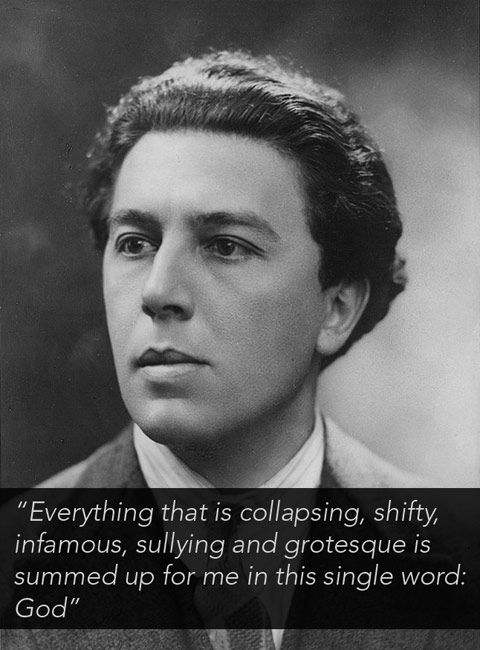
Andre Breton:
"Everything that is collapsing, shifty, infamous, sullying and grotesque is summed up for me in this single word: God"
|
SURREALISM "AS JEWISH", ATHEISM “AS JEWISH”
1. The Nazis objected to surrealism because it was atheist and
they were Christian.
2. The Nazi's associated atheism with Jews because the Nazis
were Christians.
3. The Nazi's understanding of atheism as a rejection of god
(Christ), was a specifically Christian understanding of
"atheist" in which the rejection of Christ (god) is defined by
the New Testament; it was the Jews who were the deniers of
Christ (god).
With regards to this last point,
Greek Orthodox Christians descriptions of surrealism
characterise it as "Jewish" and do so on the same grounds as
the Nazis.
Note, the quote
from the New Testament regarding “anti-Christs” (2), is the
Biblical reference to Jews who had rejected Christ as god
which was criticised in the 2009 exhibition.
THERE WAS NEVER ANYTHING IN SURREALISM THAT COULD EVER LEAD
ANYONE TO CLAIM THAT IT SERVED A JEWISH CAUSE, BUT:
There was nothing about my
work or the criticism of religion in the exhibition that
pertained to a Jewish cause of any kind, let alone "the Jewish
cause in Palestine".
The association of my
criticism of religion, with Jews, was made by Cripps. And Kyrou, the judge,
agreed that an associated benefit for the Jews of Israel arose
from my simply having criticised religion, de rigueur surrealism.
This association with Jews, and surrealism (which is atheist),
is an ongoing and consistent theme.
This association with Jews AS
A NEGATIVE that one must not support, is an ongoing and
consistent theme.
There was never anything in surrealism that could ever lead
anyone to claim that surrealism served a Jewish cause,
interest, or purpose, but that did not stop various
antisemites, such as the Nazis, from proclaiming that
surrealism aided Jewish interests and claiming that it was
Jewish.
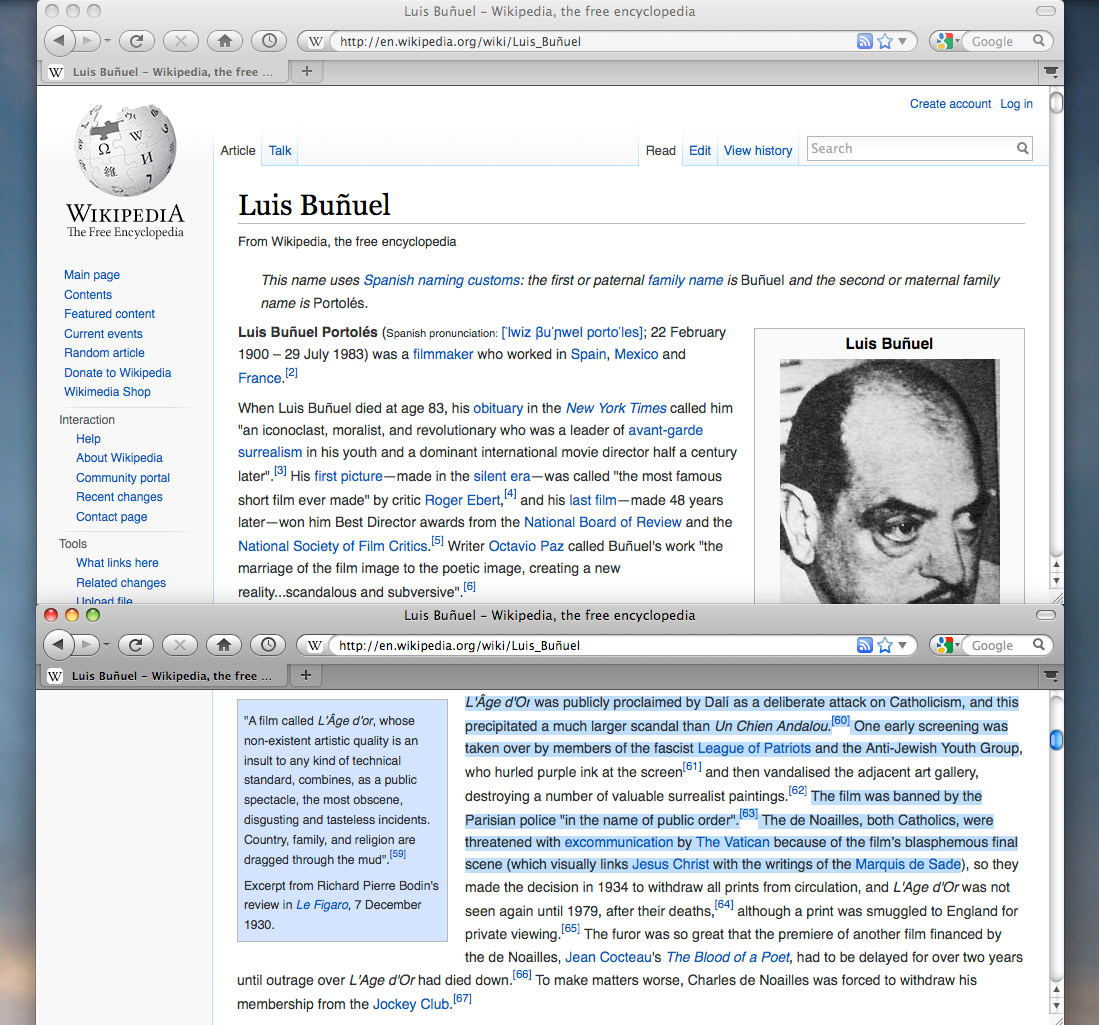
(3)
Surrealism
as anti-religion "pro-Jewish". The case of L'Âge d'Or
When Dalí proclaimed Buñel's film L'Âge d'Or to be a
deliberate attack on Catholicism the result was an attack of
the theatre it was screening in by the "Anti-Jewish Youth
Group".
It needs to be EMPHASISED that this film with a complete
absence of reference to Jews, was associated with Jews because
the film attacked religion, Christian religion. According
to Christian doctrine, (the New Testament), an attack on
religion and rejection of god means “the Jews" and
Christians define "atheism" through the prism of their
irrational faith. Greek Orthodox Christians continue to
denounce surrealism as "Jewish".
When the Nazis came to power, surrealism, which was known to
be avowedly anti-religious, was targeted, because
the Nazis were Christians. (See also, Hitler,
the perfect Christian)
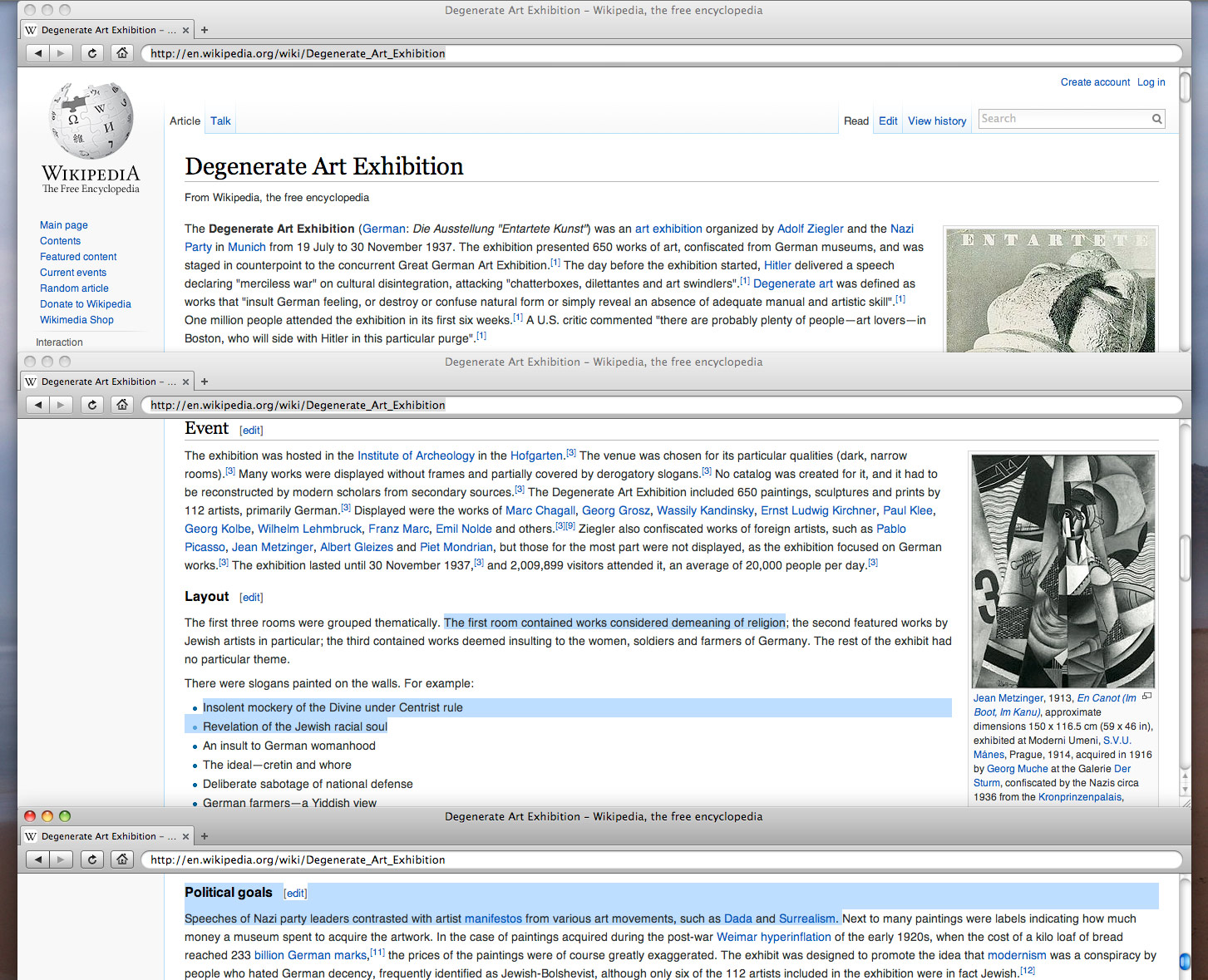
(4)
In the infamous Degenerate
Art exhibition organised by the Nazis, the first and foremost
objection to the artists exhibited was that their works were
“demeaning of religion”. The Dadaists were attacked as an
example of the Jewish degradation of culture. Slogans derided
the art for its “insolent mockery of the divine”, and claimed
the art to be a “revelation of the Jewish racial soul”.
Max Ernst, the Dadaist/surrealist was named and one of his
works prominently featured. That work, Ernst's 1923 painting,
"The Creation of Eve," or La Belle Jardinie're, (“The
Beautiful Gardener”) was deemed offensive.
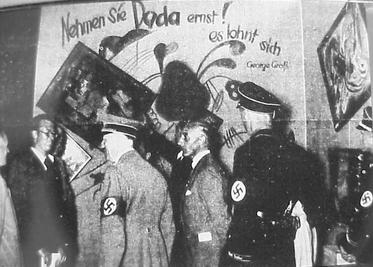 (5) Hitler entering the
notorious Entartete Kunst (degenerate art)
exhibition in 1937. The signage reads "Dada" (out of
which evolved surrealism), and refers to the
surrealist "ernst" (Max Ernst).
(5) Hitler entering the
notorious Entartete Kunst (degenerate art)
exhibition in 1937. The signage reads "Dada" (out of
which evolved surrealism), and refers to the
surrealist "ernst" (Max Ernst). |
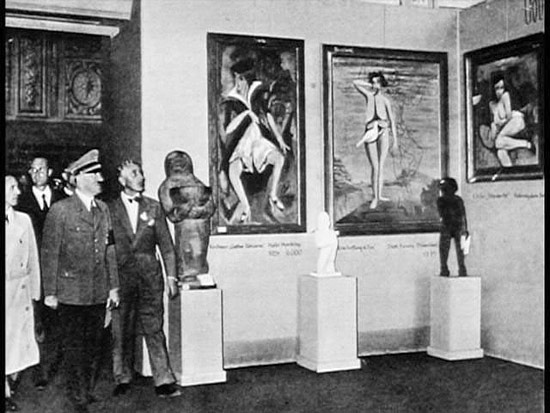 (6) Hitler inside the
Entartete Kunst (degenerate art) exhibition in 1937.
Max Ernst's painting, The Creation of Eve
can be clearly seen.
(6) Hitler inside the
Entartete Kunst (degenerate art) exhibition in 1937.
Max Ernst's painting, The Creation of Eve
can be clearly seen. |
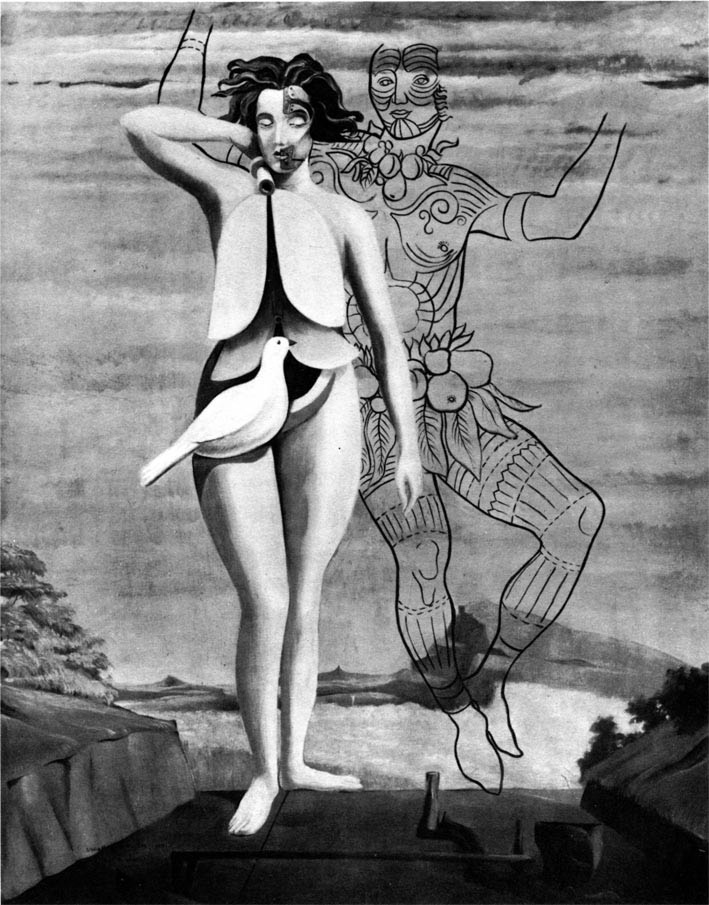
(7)
Max Ernst's, The Creation of Eve, offensive to
Nazis, "demeaning to religion" and an "insult to German
womanhood". The whereabouts of Ernst's work, or whether it survived the Nazis, is unknown.
--------------------
It was the Christianity of the Nazis that led to both the
targeting of surrealists (atheists), and attributed to Jews
the surrealists’ atheism.
And it is this very fact, that the Nazis were Christian, that
Kyrou made certain is now unlawful to reference. To do so now:
1. constitutes an "association" with Hitler (and the Nazis)
which Kyrou ruled constitutes an "egregious defamation"; and,
2. Kyrou ruled that the Nazis committed their genocide of Jews
because of some innate “Aryan Supremacist" racism and not
their Christianity which was criticised in the 2009
exhibition.
In Australia, judge Emilios Kyrou has ruled that histoical references can be prohibited by law since they can "associate" an idea held by an individual with an idea held by someone "universally (or widely) reviled". And since ideas are held by individuals who believe their ideas define them, showing the ideas they hold were also held by people reviled will cause such persons to be "defamed".
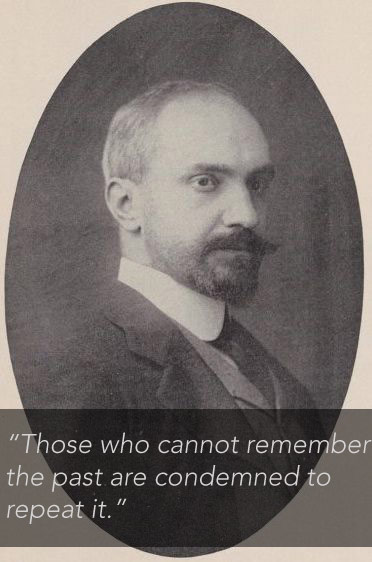
George Santayana:
"Those who cannot remember the past are condemned to repeat it."
|
See
also vakras-art-unlawful.html
| A belief
is not the equivalent to a logical corollary.
And, a logical corollary is not "an opinion".
Australia's judiciary conflate these concepts and deem
them to be of the same meaning. |

